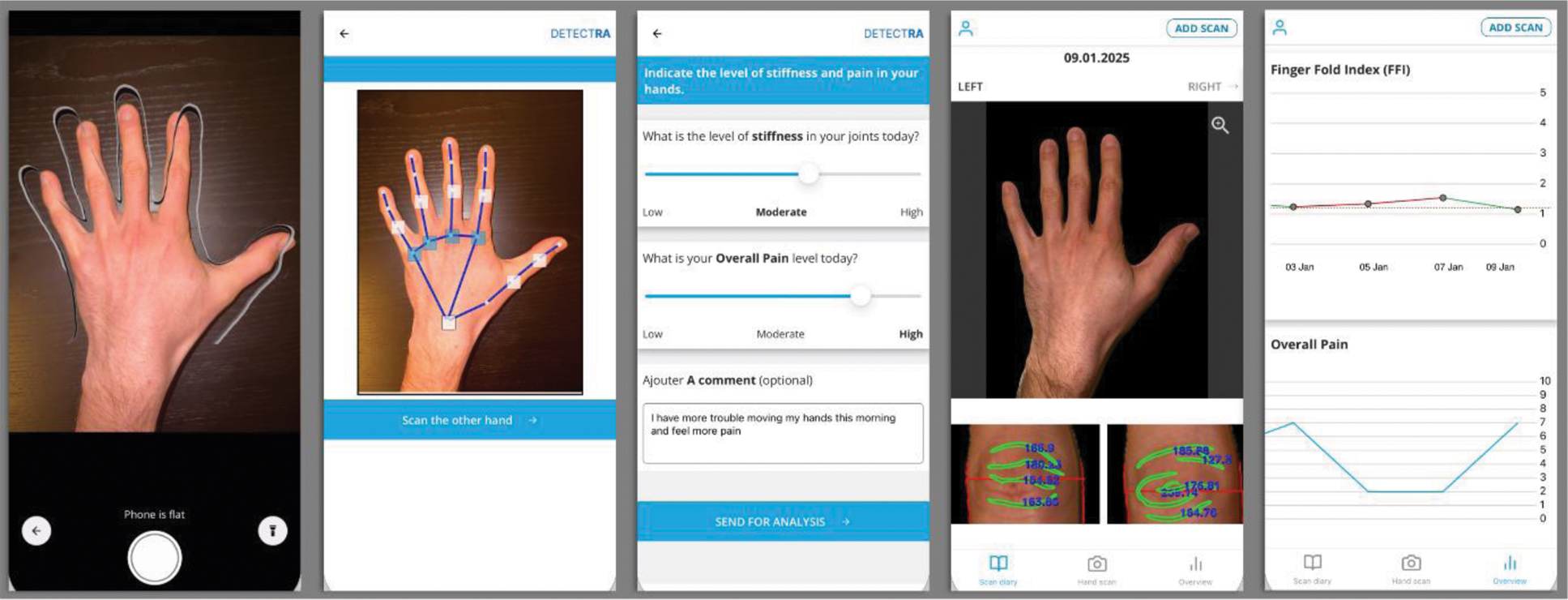

Background: There is a shortage of healthcare providers in rheumatology, leading to delayed appointments and diagnoses [1]. Innovative approaches are needed to improve access to care. Remote patient monitoring (RPM) is a promising solution to reduce the frequency of in-person appointments or perform first evaluations of rheumatic symptoms. Most RPM strategies only collect subjective patient reported outcome measures (PROMs) and more objective measures are needed to assess a patient’s state, notably in inflammatory rheumatic disorders.
Objectives: To further develop and implement a multimodal (PROMs and hand photos) remote monitoring mobile app for patients with inflammatory arthritis. To ensure a user-centered design and assess the application’s usability by conducting qualitative user experience research. To evaluate patient acceptance of AI solutions in medical care.
Methods: We created DETECTRA a multimodal mobile app (Figure 1) that allows patients to take hand photos along with PROMs and text-based comments. Photos are further analyzed by machine learning models that automatically measure joint diameter and finger fold patterns to monitor joint swelling (Finger Fold Index, FFI [2]). Photos are shown in the app as either entire hands or cropped proximal interphalangeal (PIP) joints with FFIs. The patient can scroll horizontally to see the other hand or PIP joints and vertically to compare swelling and painful joints on a single joint level. A minimal set of PROMs is collected, namely global pain score, stiffness levels and painful joints indicated directly on images (= visual PROMs ). We performed semi-structured interviews with patients (n = 7) in the rheumatology department to collect feedback and onboard them on the app. Patients’ age ranged from 25 to 65 with a mean age of 54. Post-interview semantic analyses were done using the Capability-Opportunity-Motivation (COM) framework. In a co-design approach, the app was improved after the interviews. A first assessment of utilization and adherence without reminders was done after 2 months.
Results: During the semi-structured interviews, 86% (6/7) of patients said they could use a phone despite their inflammatory arthritis and 57% (4/7) believed to be confident with technologies. 71% (5/7) found the app intuitive for taking hand photos and entering PROMs but 57% (4/7) suggested simplifying the sign-up process. As for the strongest motivators to use the app, 71% (5/7) of patients indicated they wanted to help their doctor and 43% were interested in monitoring their arthritis with an objective AI-based tool. Figure 1 shows the updated app incorporating patient’s suggestions, such as the option to write comments. As for the 2-month assessment of utilization and adherence, it showed that 57% (4/7) of patients are taking photos regularly. The number of photos taken per month varies from 1 to 6 with a mean of 3.4. In 50% (2/4) of patients, a higher frequency of photos taken was seen when PROMs levels were higher, suggesting that patients are more active when they have more pain or stiffness.
Conclusion: Co-design is crucial for creating useful patient mobile applications and ensuring long-term adherence and impact. Simplicity, the combination of images and PROMs in the form of visual PROMs, and AI integrations were well received but need further improvement.
DETECTRA App updated with patient’s feedback. Left to right : Frame to take photos; Indication of painful joints on photo (visual PROMs); Minimal PROMs and comment collection; Entire hands and cropped PIP joints with AI-based analyses; E. Graphs of PROMs and AI-monitoring of joint swelling (FFI).

REFERENCES: [1] Eli M. Miloslavsky et al. The Challenge of Addressing the Rheumatology Workforce Shortage. The Journal of Rheumatology Jun 2022, 49 (6) 555-557; DOI: 10.3899/jrheum.220300.
[2] Hügle T et al. Dorsal Finger Fold Recognition by Convolutional Neural Networks for the Detection and Monitoring of Joint Swelling in Patients with Rheumatoid Arthritis. Digit Biomark. 2022 Jun 8;6(2):31-35. doi: 10.1159/000525061.
Acknowledgements: NIL.
Disclosure of Interests: Lorenzo Russo: None declared. Marc Blanchard Atreon, Jules Maglione: None declared. Patrick Hermann Atreon, Cinja Koller: None declared. Thomas Hügle Abbvie, GSK, BMS, Novartis, Lilly, Werfen, Fresenius Kabi, Atreon, Vtuls.
© The Authors 2025. This abstract is an open access article published in Annals of Rheumatic Diseases under the CC BY-NC-ND license (